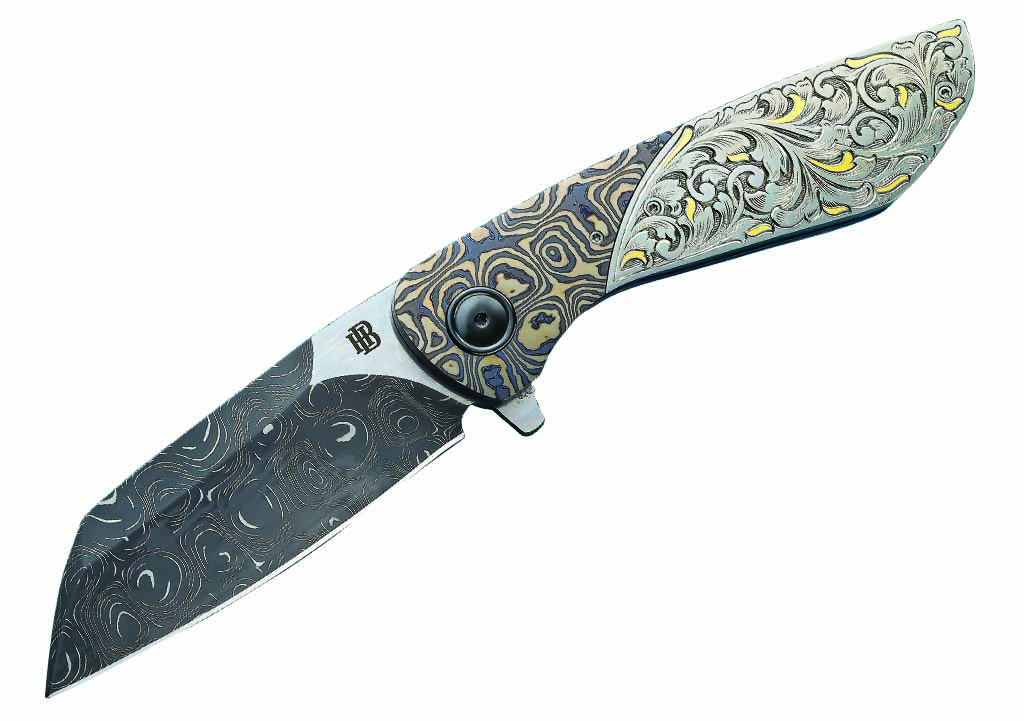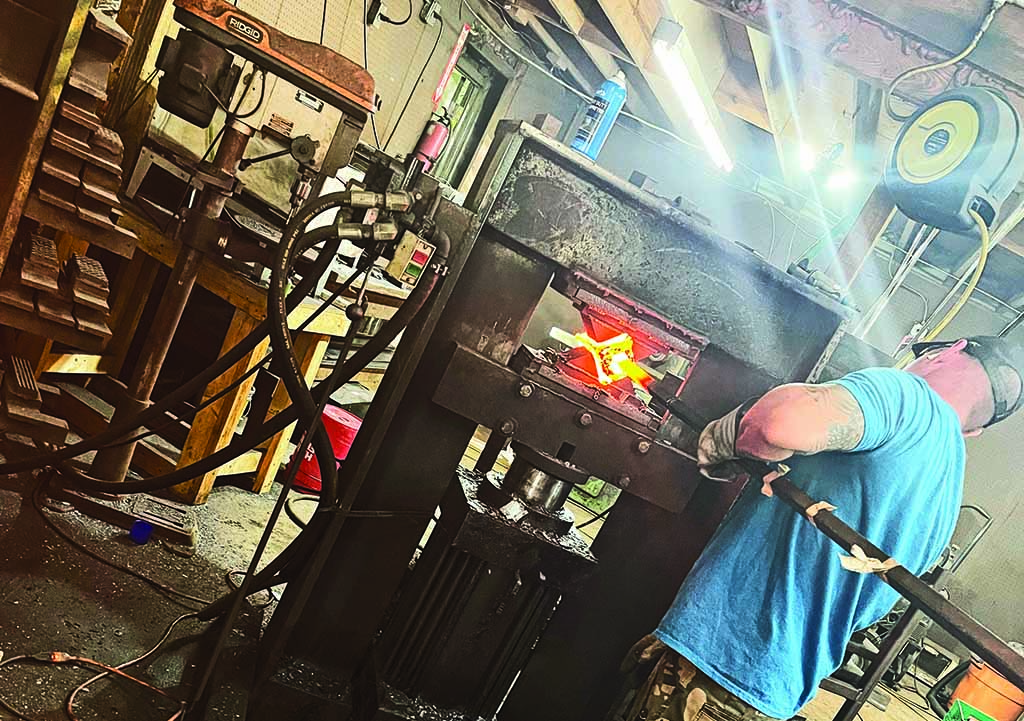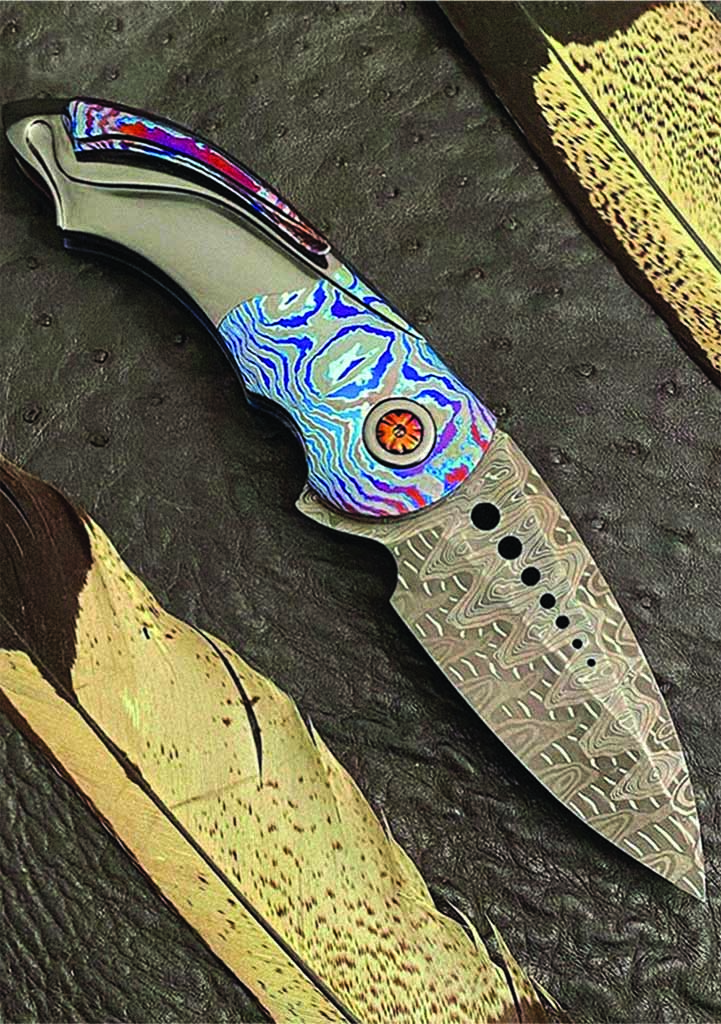
Stainless damascus knives look fantastic and resist rust in the process, but present the knifemaker with a host of challenges.
It’s not easy forging stainless steel. It’s harder still to forge damascus patterns out of it. Nonetheless, those who specialize in forging stainless damascus for sale to both factory and custom knifemakers, who spend their days before a power hammer turning out billet after billet, say the material is as hot as ever. Meanwhile, they’ve developed a couple of tricks to keep the welds sure, the patterns crisp and the innovation marching forward.
“There’s just things that I’ve been able to do now that I thought I wouldn’t have been able to do when I first started,” said Mike Norris, a smith of stainless damascus since the mid-1990s. “For instance, I actually make Turkish twist damascus in stainless.”
Norris runs a one-man operation in his Kentucky shop. In a moment when he wasn’t moving between his forge and Blanchard grinder, he explained part of the process. “When you forge carbon steel, you can use flux. You can just stack the layers up and flux ’em and stick it in a fire and make it weld like that. With stainless, you have to have a controlled atmosphere around the billet,” he explained. “Flux doesn’t work on it.”
Stainless Damascus Forging Process
If the weld in a carbon damascus billet doesn’t take, a smith may have an opportunity to get another whack at it. No so with stainless damascus. There’s one shot and if it doesn’t fuse, the billet heads to the scrap pile. Moreover, no oxygen can touch the stainless steel during the process. While other smiths build a can, fitting metal in some kind of container, fusing it shut and then launching into forging, Norris uses stainless foil.

Stainless damascus is as popular as ever, Norris says. His patterns most in demand are Fire Clone and Hornet’s Nest, and he typically forges them from 19C27 and 302 stainless and D2 tool steels. In the past few years, he said he’s seen many makers grind blades from san-mai, a blade material with a core of hard steel sandwiched by softer ones.
Tired of seeing a core sit off center on a finished knife, lopsided between two outer layers, Norris developed straight-core san-mai. He’ll cut a damascus billet in half, sandwich it between sides of an XHP stainless, and forge weld it all together. The result keeps the core centered and the pattern undistorted. That way when the maker takes the steel to the grinder, the core is “gonna be there every time,” he said.
All that effort helps the end-user rest easy, Norris opined. Instead of worrying about caring for a carbon blade, a stainless damascus one has the corrosion resistance and can look good doing so. One other benefit, Norris said: it can hold its contrast. The knife Norris has taken bowhunting for about two decades—made with one of his early billets of stainless damascus—looks almost as good as the day he made it. “And,” he exclaimed, “I’ve skinned a lot of deer with it!”
Experimenting With Stainless Damascus
Forging stainless damascus requires a willingness to go off map. It’s not the land of 1080 carbon steel.

Chad Nichols of Chad Nichols Damascus can typically devote time to experiment in December, when business slows down somewhat and he and his shop of five have a little extra time. Plus, the summer temperatures in his Mississippi-based locale can sometimes get downright hellish.
Chad’s shop turns out a range of knife materials, including titanium damascus, Mokuti, carbon damascus and stainless damascus. Boomerang and Wave Pool have been damascus patterns popular with his customers, as have the san-mai-type billets.
According to Chad, damascus essentially breaks down into two basic patterns: raindrop and ladder. Lately, though, he’s been trying out new types of steel. He’s been forging san-mai billets with unusual core steels. Hearing recently that CPM MagnaCut, a 4V-type of steel, might be the next hot blade material, he started using it as the core.

And just how do you go about working with a new steel?
“Guess,” Nichols blurted, laughing. “Start off with a pretty good educated guess and go from there. I mean, it still is steel, each one has a characteristic, but you just got to kind of baby step it until you figure it out. Then take notes.”
Once he’s figured a steel out, it’s smooth sailing—mostly.
“The first time, yeah, but after that, it’s just like anything else. I’ve been doing it for almost 20 years and if there’s one thing, it will take you to school,” he said. “Each one of them moves different, takes the heat different. There’s some steels you have to be super careful about not overheating them like by 20 degrees.”
Yes, sir, some like it hot.
Pattern Making
According to Jesse Harber, president of Vegas Forge, it was just seven years ago that the average consumer didn’t know what damascus was. Now, they see it on Forged in Fire and know.

The vast majority of Vegas Forge’s business is stainless damascus. Because it works with mosaic damascus—building patterns in a can, sealing it and applying the heat—Vegas can also put, say, a proprietary logo straight into the steel. Out of the 16 patterns Vegas Forge offers, Herringbone and Spirograph are the hot ones. They are patterns born out of some serious development.
A few years ago, “we modified from MIG welding to TIG welding, which gave the can a lot tighter seals, so there’s no holes in it,” Harber said. “And we advanced the system that we used, actually worked with some engineers out of California, a couple of good old Russian boys. That’s probably the biggest advancement we’ve made.”
The thing they try to prevent? A bad weld, something that would become all too apparent if the billet was milled and the steel started peeling apart.

After forging the stock down to an inch thick, “from there, we’ll use the rolling mill to roll it out. It takes a lot more time to do it that way but the pattern stays crisp,” Harber noted. “It doesn’t blend or blur the layers together from all the impact.”
Amidst all the innovation, the “crazy wizardry” of pattern development, Vegas Forge has expanded outside the knife industry. It also supplies round stock to jewelry makers for men’s rings, for instance.
As it turns out, plenty of people appreciate the ease-of-care and mesmerizing patterns from a good piece of damascus made from stainless steel.
 NEXT STEP: Download Your Free KNIFE GUIDE Issue of BLADE Magazine
NEXT STEP: Download Your Free KNIFE GUIDE Issue of BLADE Magazine
BLADE’s annual Knife Guide Issue features the newest knives and sharpeners, plus knife and axe reviews, knife sheaths, kit knives and a Knife Industry Directory.Get your FREE digital PDF instant download of the annual Knife Guide. No, really! We will email it to you right now when you subscribe to the BLADE email newsletter.






